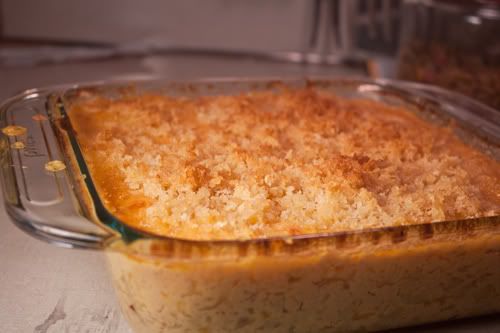One of the first episodes I watched of Good Eats involved various was to make mac and cheese. My personal favorite rendition is done quite nicely with Velveeta's Rotini & Cheese (with broccoli!). Honestly, it puts Kraft's version that I grew up with to shame.
I was never a fan of the cassarole form of macaroni and cheese, but I don't recall ever actually trying it. It just looks bad; stiff clumps of wierd smells, almost gelaton with it's jiggle. But, I'm open minded. If Alton says that it can be good eats, well, who am I to deny him a try?
I compiled the ingredients that were not already in my kitchen.
1. Cheese: The recipe on the show says English cheddar, but the one on foodnetwork.com says sharp cheddar. I'm guessing if it's cheddar, it's ok. That may have been my first mishap, as I couldn't find anything that was english cheddar, so I chose some cheese that was from England. It didn't quite turn out to be cheddar, rather, a mild cheese with a distinct kick. Lesson learned. CHEDDAR!
2. Elbow pasta: This is, admittedly, my least favorite pasta shape. When I was growing up, I always avoided this shape in the Kraft mac & cheese boxes. It felt slimier in my mouth, and didn't taste as good. Alton gives the shape a good case for it's use, claiming that the hole through it and the surface area are just the right size for the right amount of cheese to coat.
3. Kosher salt (new ingredient of the week!): Before this purchase, I already had sea salt and table salt. The main differences betweek kosher salt and regular table salt are that iodine is often added to table salt, and the grain size (kosher is larger). Because of the larger size, it's easier to measure by hand. Kosher salt isn't actually kosher itself, rather, it is used to make meats kosher. I
4. Panko (Also new ingredient!): Panko is a type of breadcrumb that originated in Japan. In some dishes, regular breadcrumbs can be a substitute for panko. Panko is normally used in tempura dishes.
The pasta is cooked, then rinsed in cold water. Alton claimed this was to stop the cooking process, but my main concern was that all the starches were being washed away down the drain.
A rue is made, and dry mustard, paprika, onion, and a bay leaf are added. After combined, milk is added. An egg is tempered into the mixture, and the cheese is folded in. The sauce is poured into a cassarole dish with the noodles mixed in, topped with cheese and panko.
Looks alright. Tasted crappy. However, this is personal taste. Jeff informed me that it tasted pretty much like any other baked mac & cheese he's had. It's good to confirm my taste bud's dislikes.

No comments:
Post a Comment